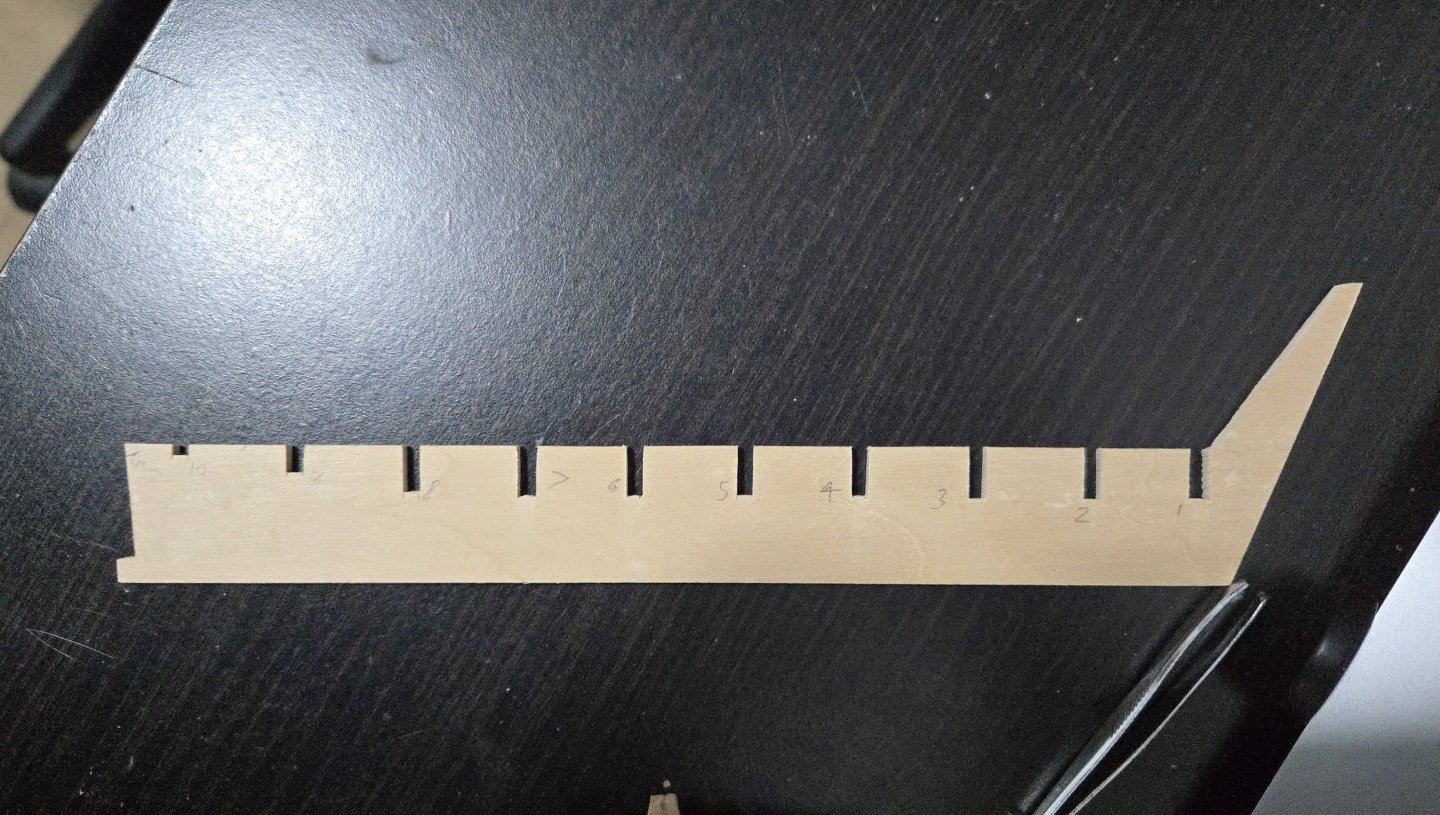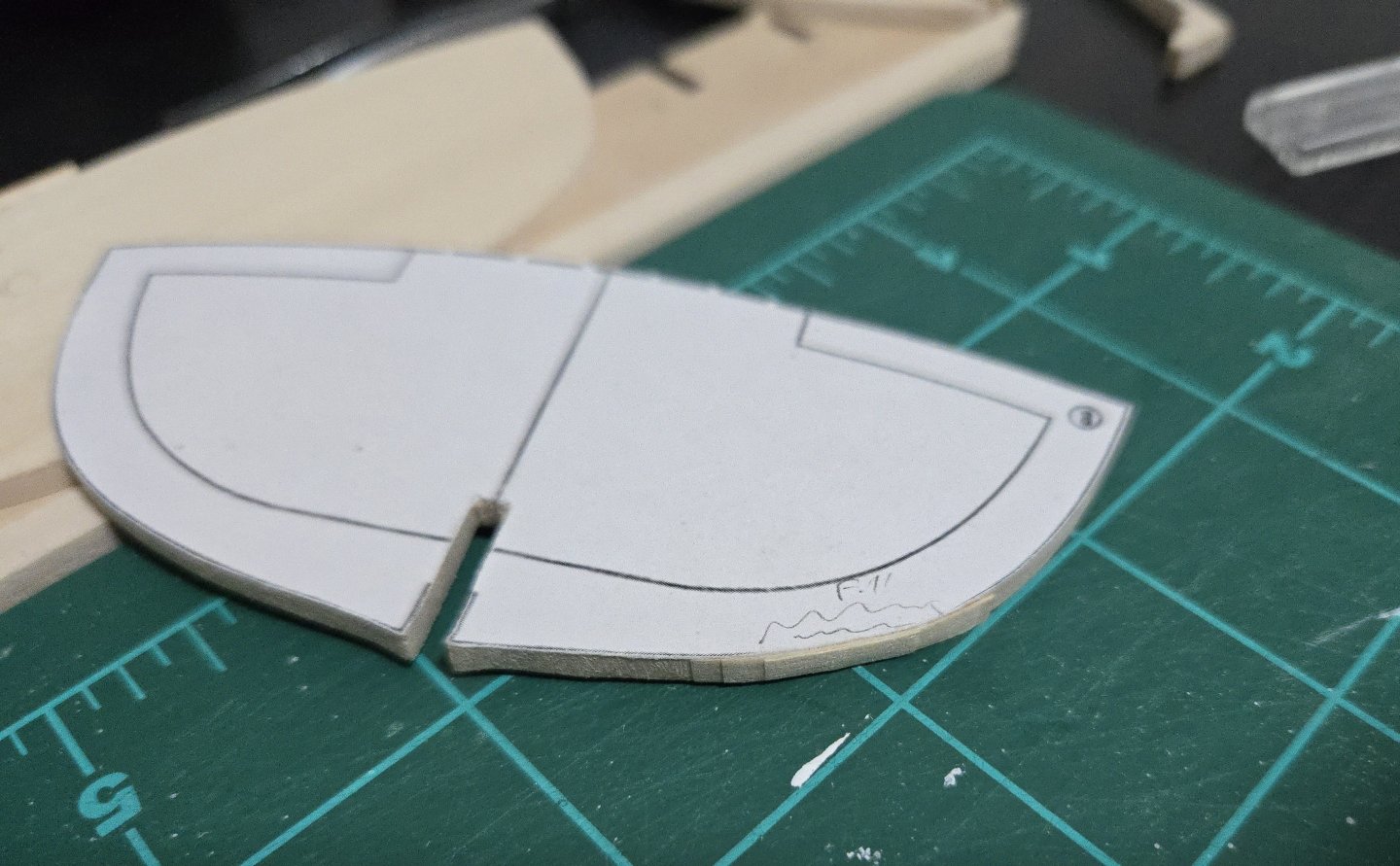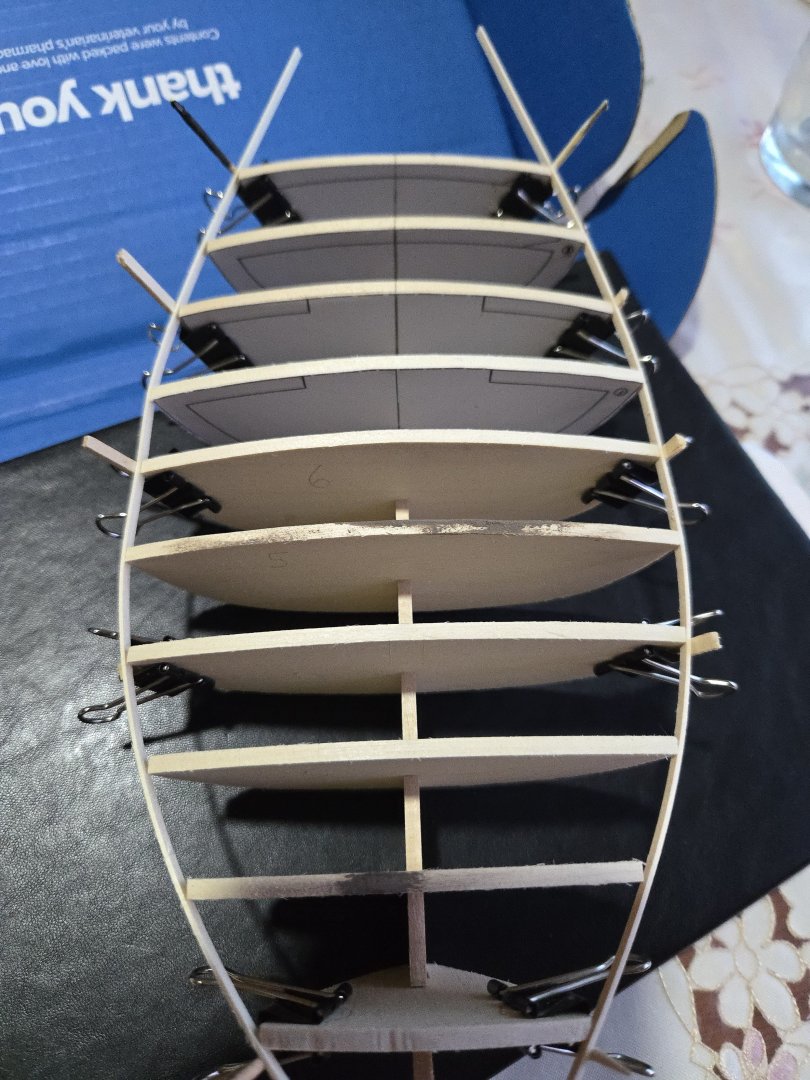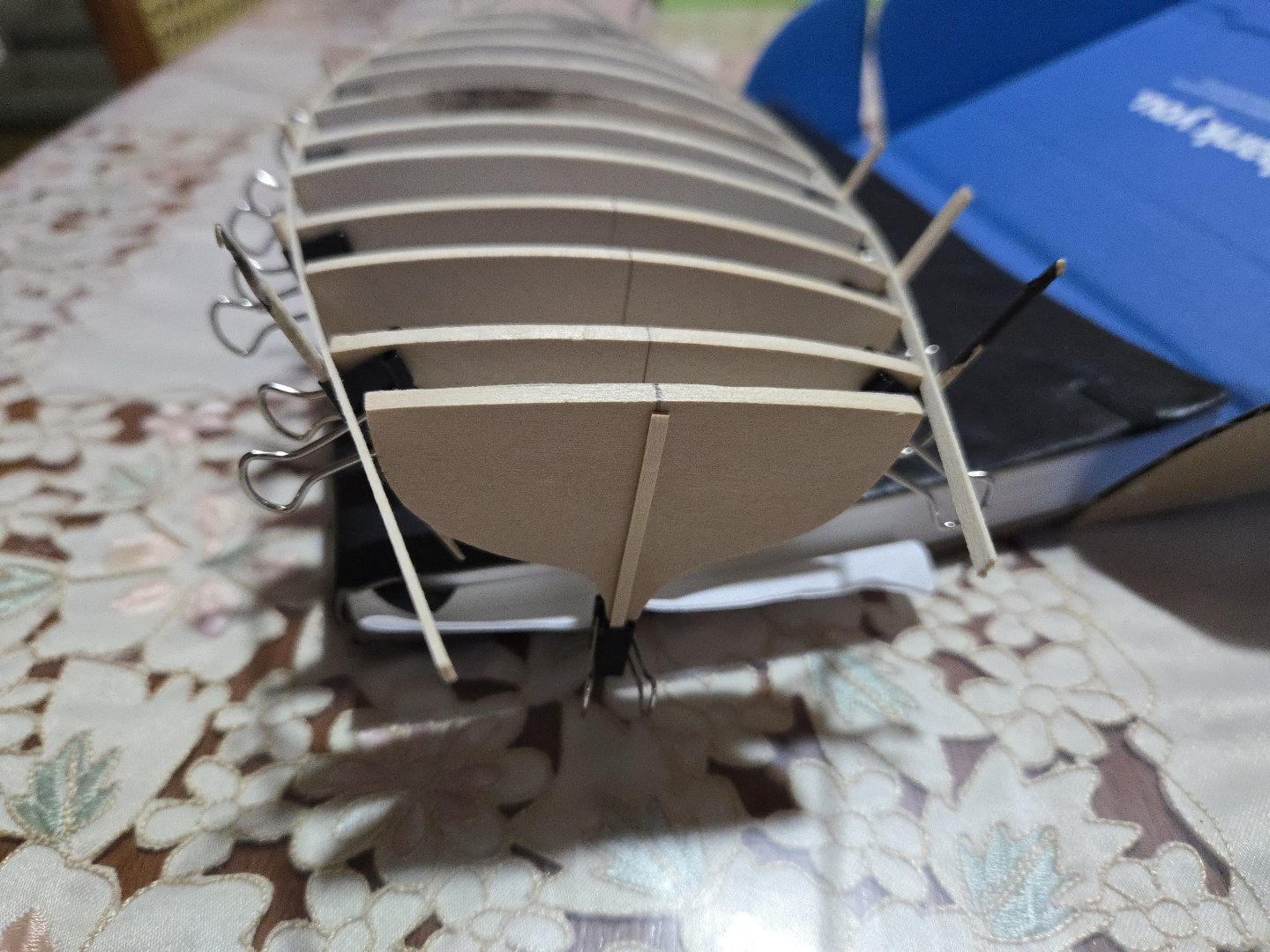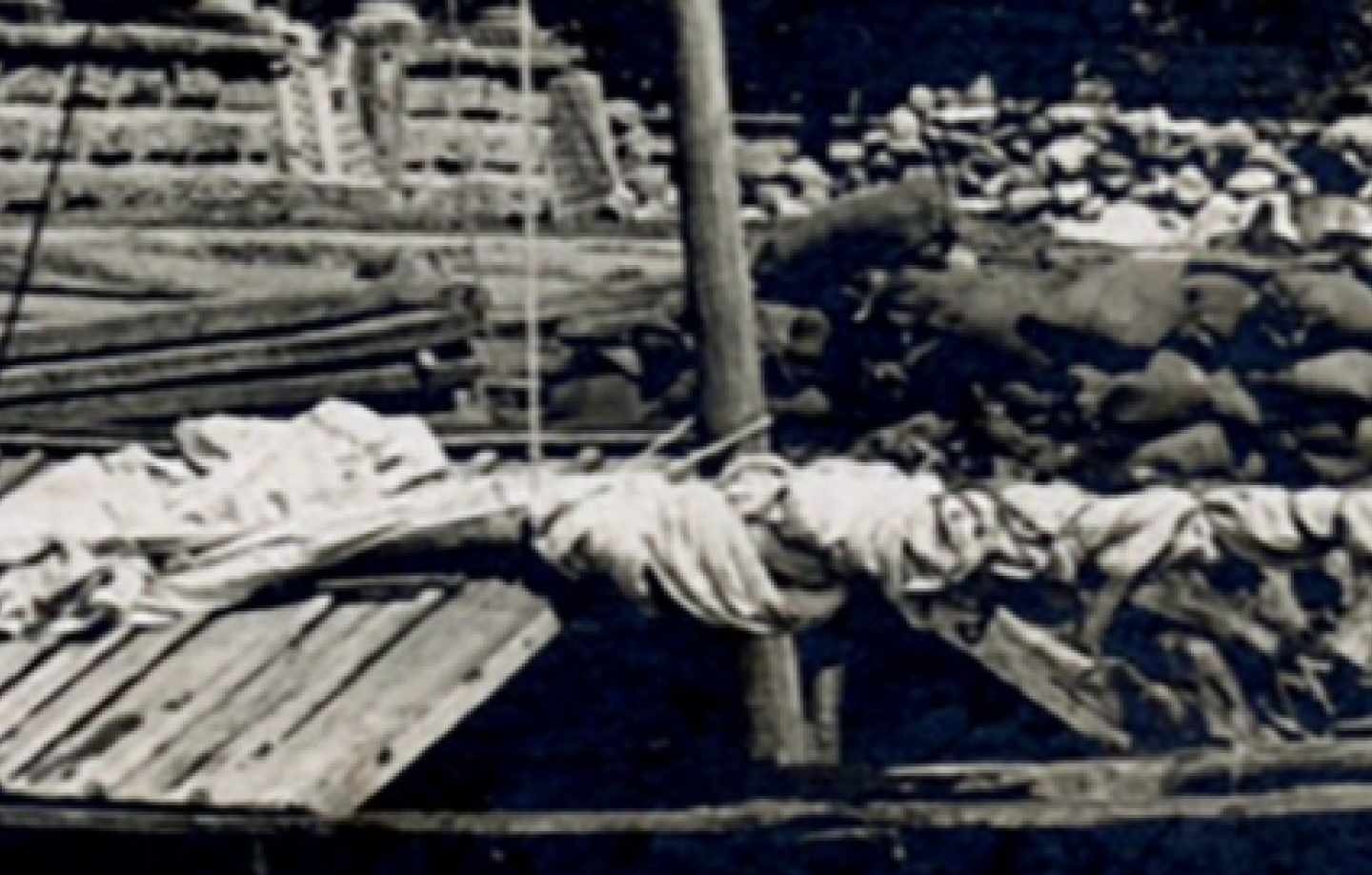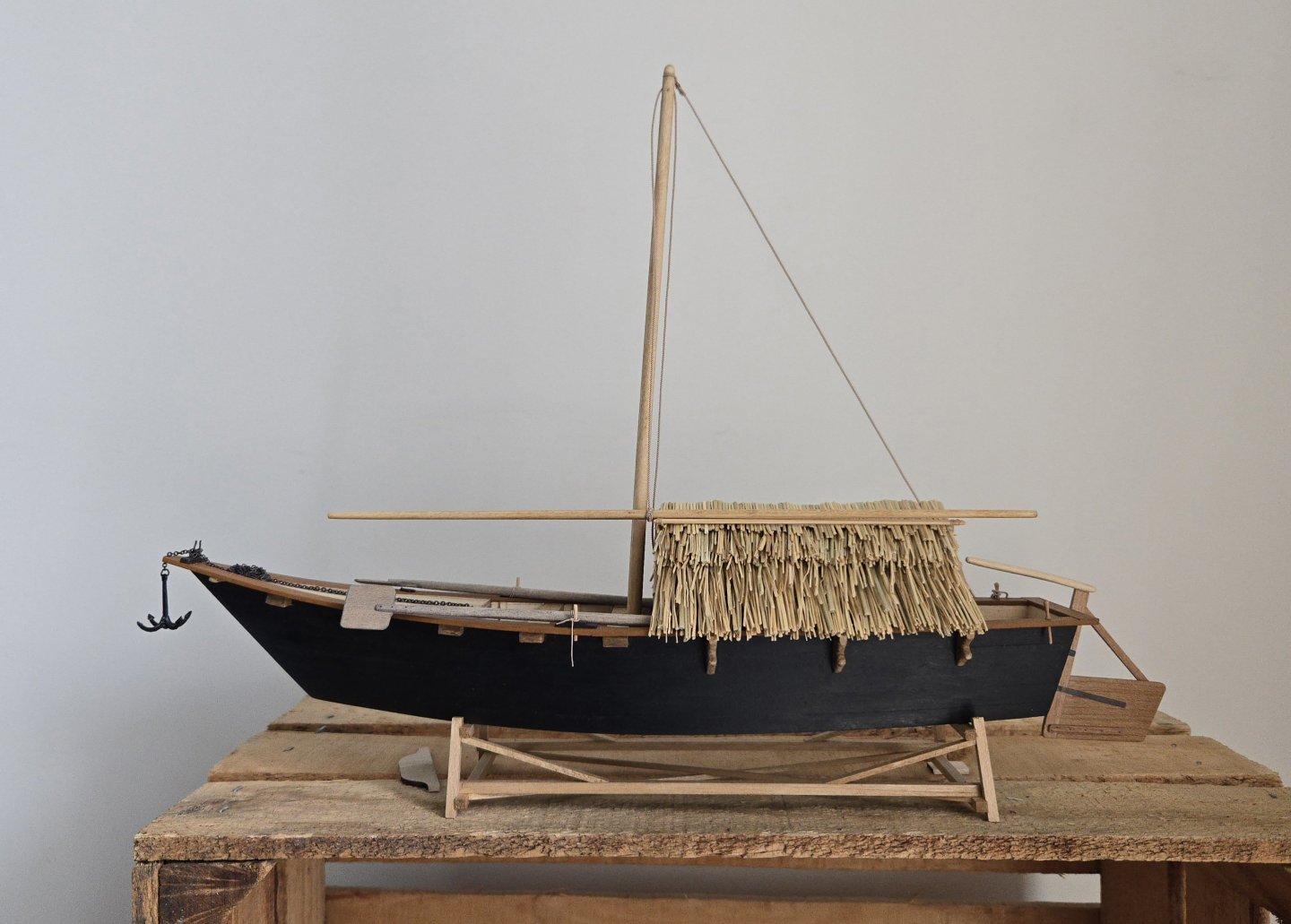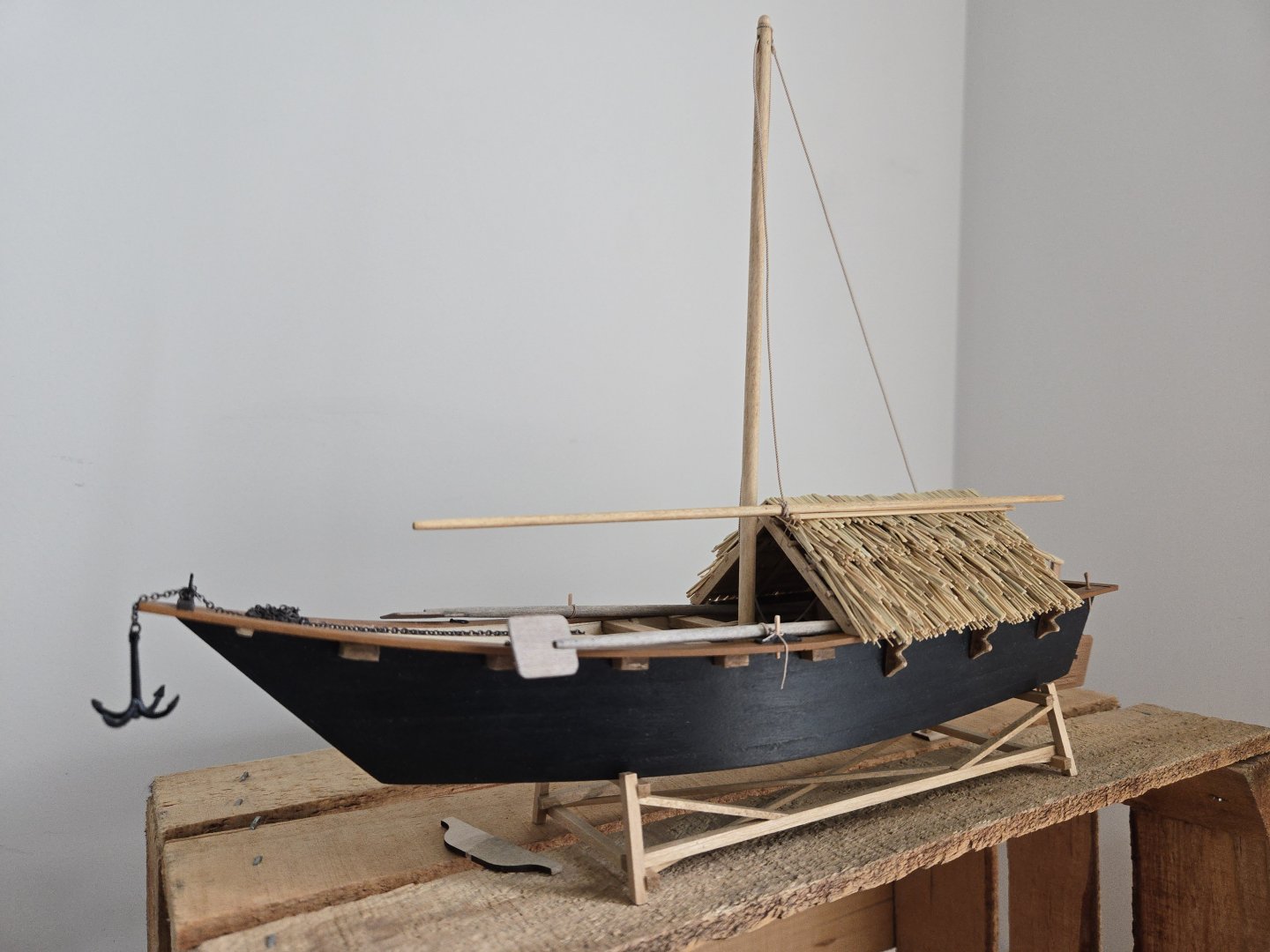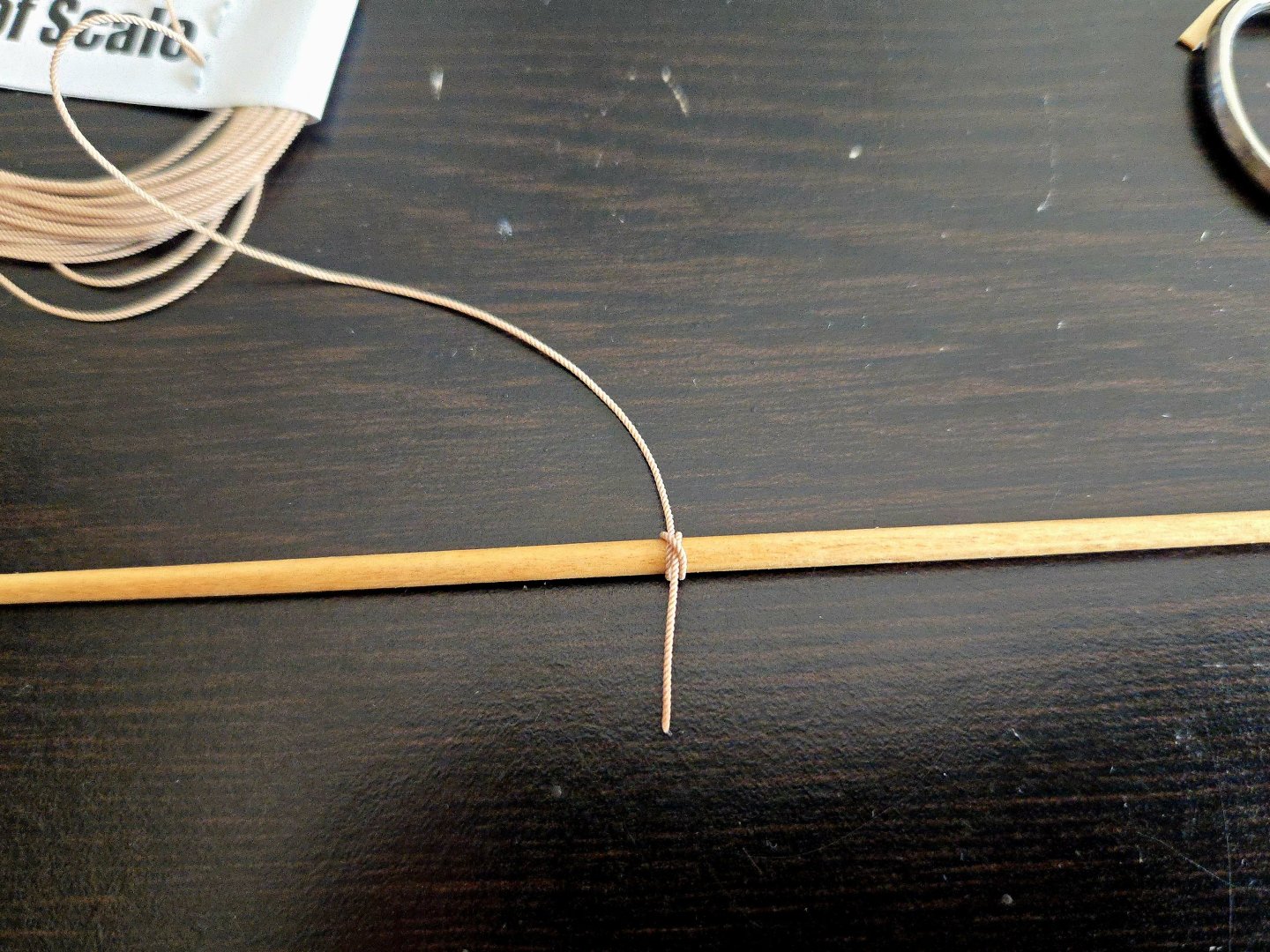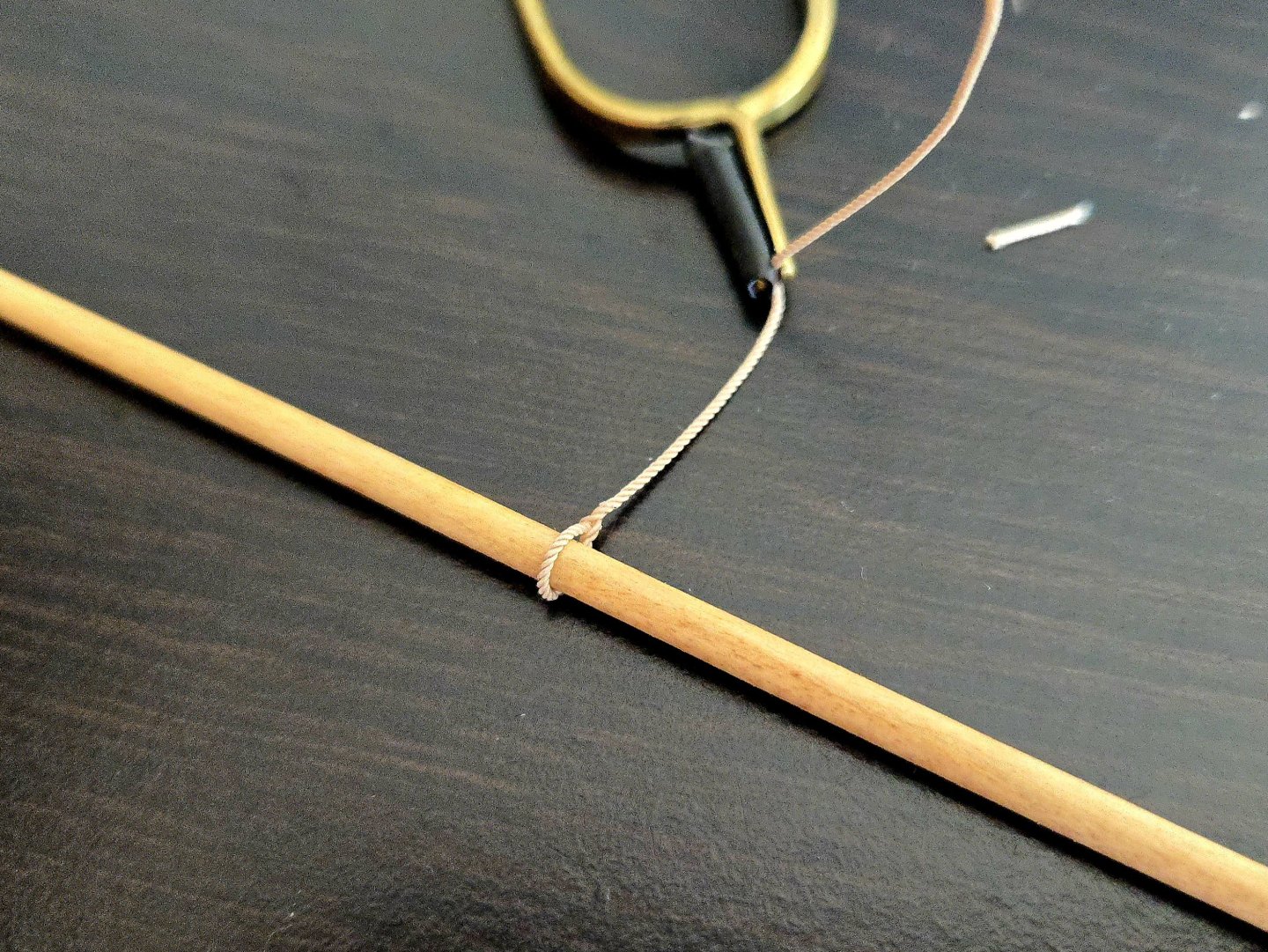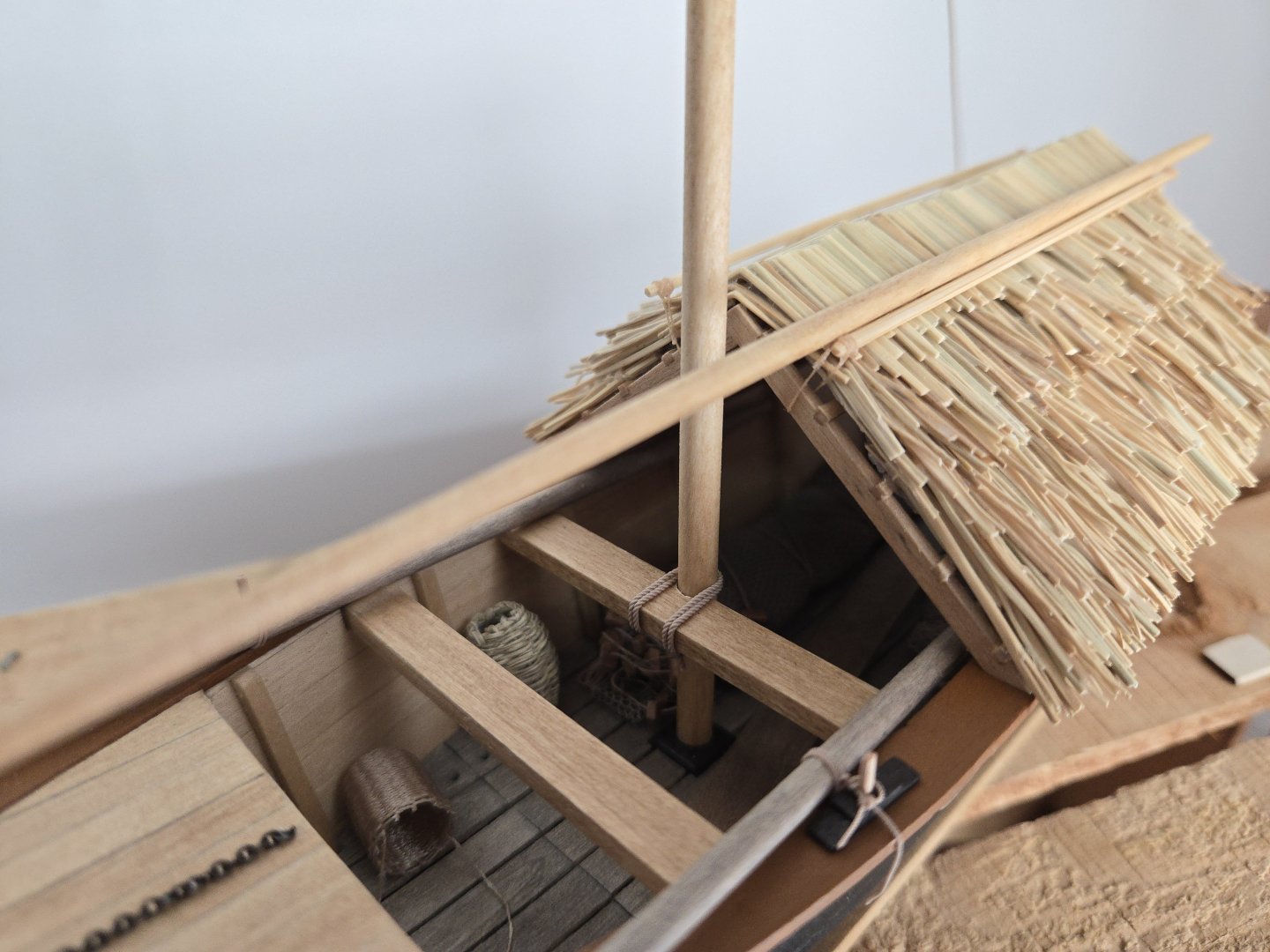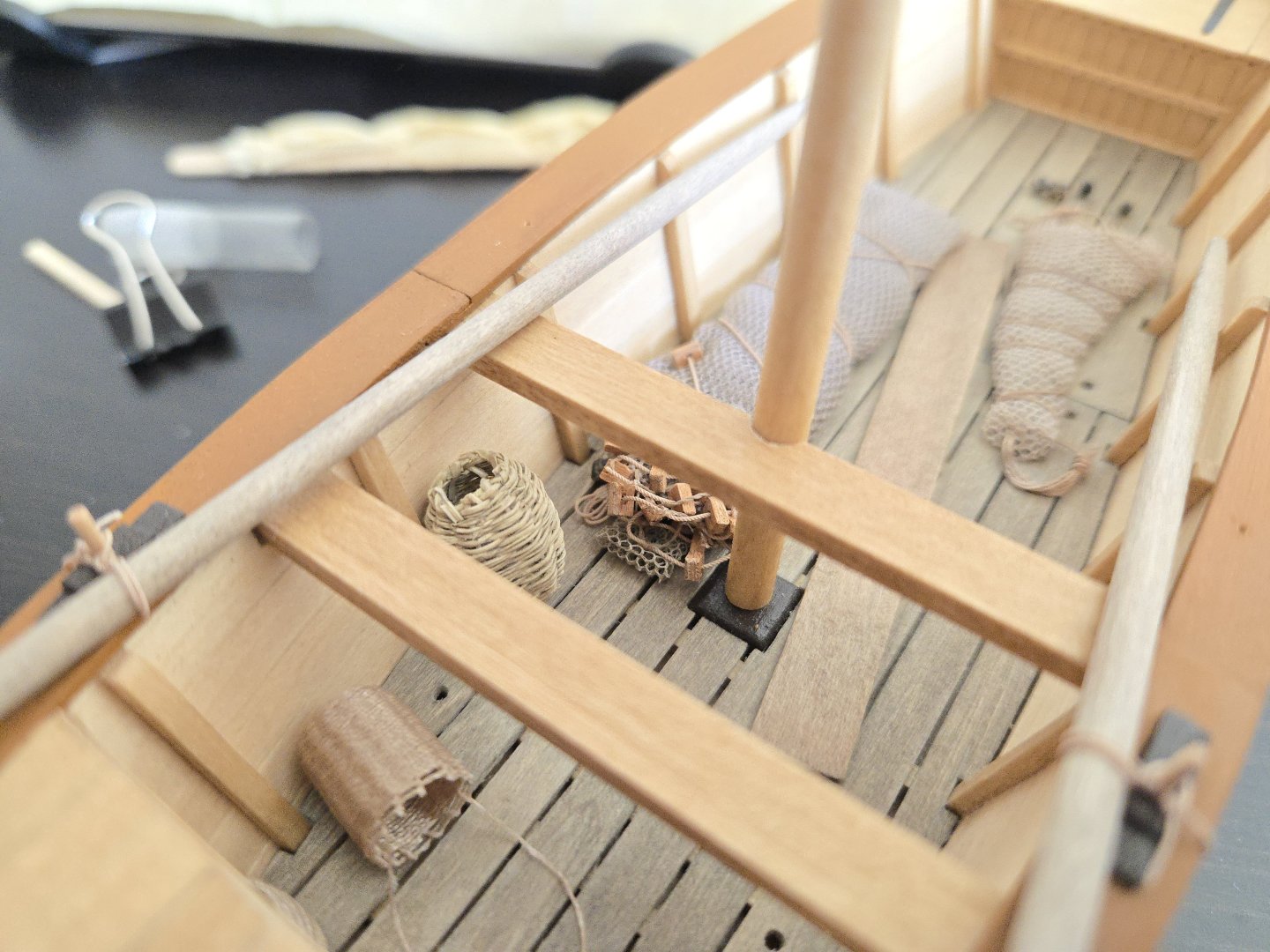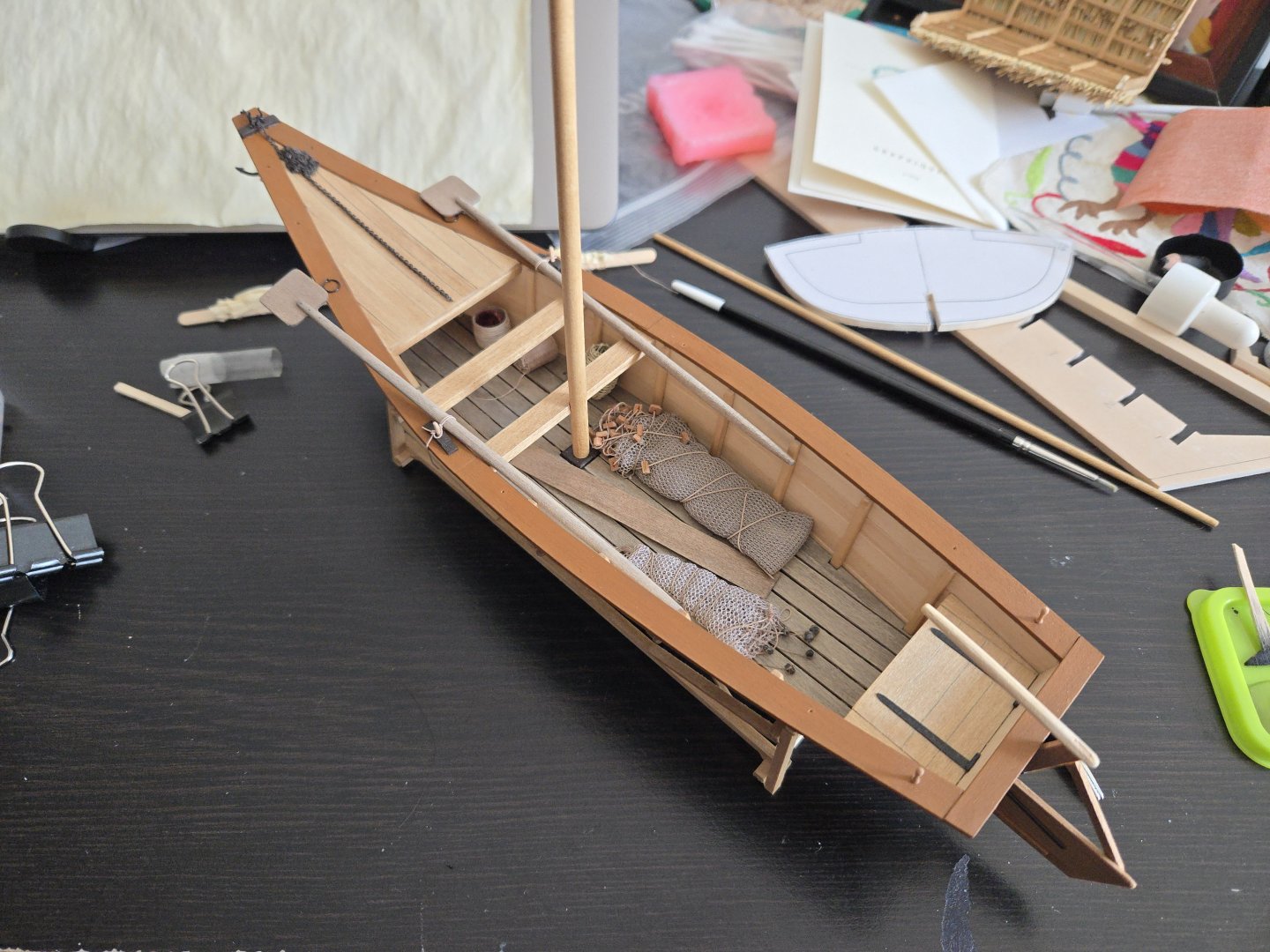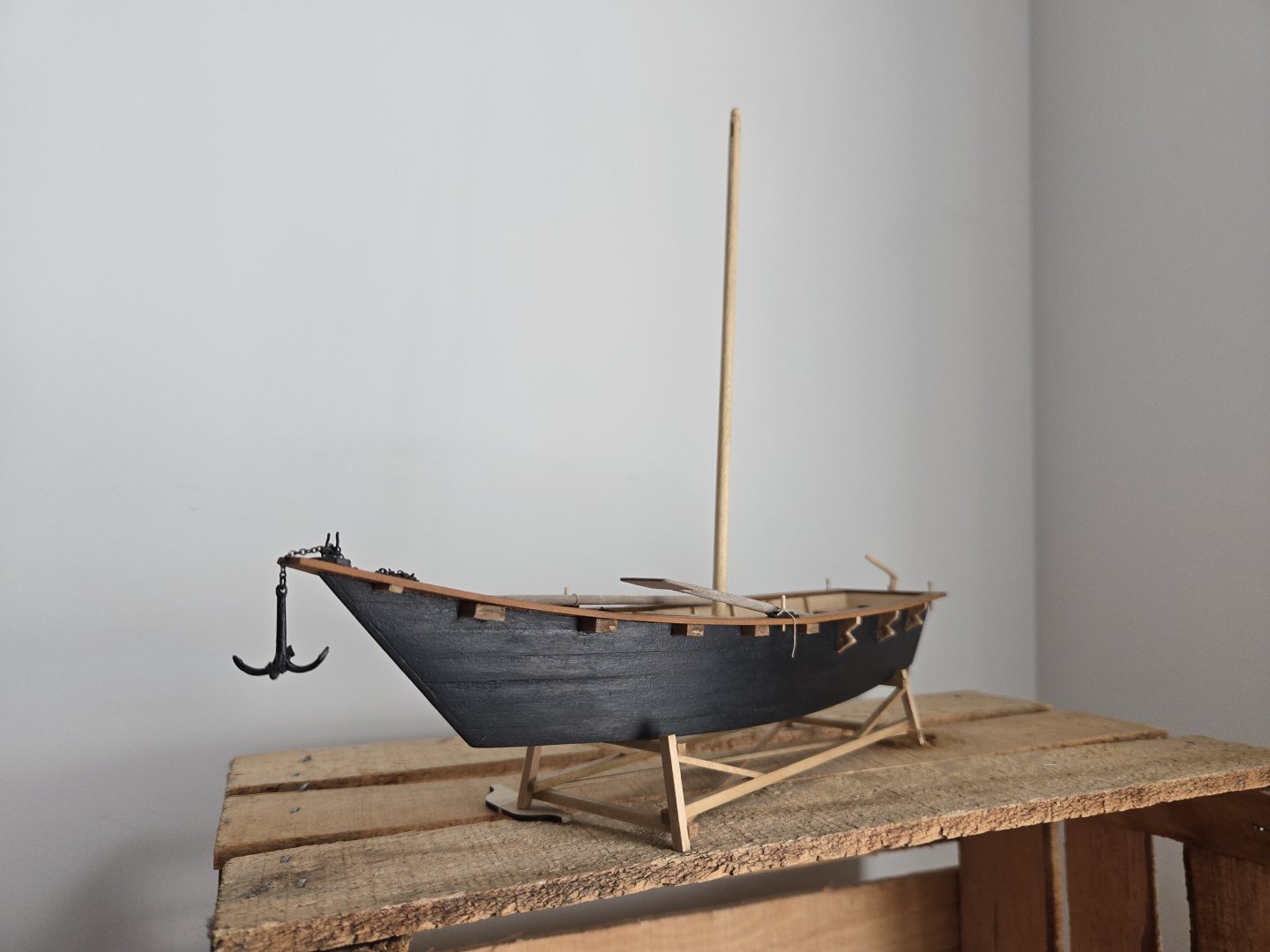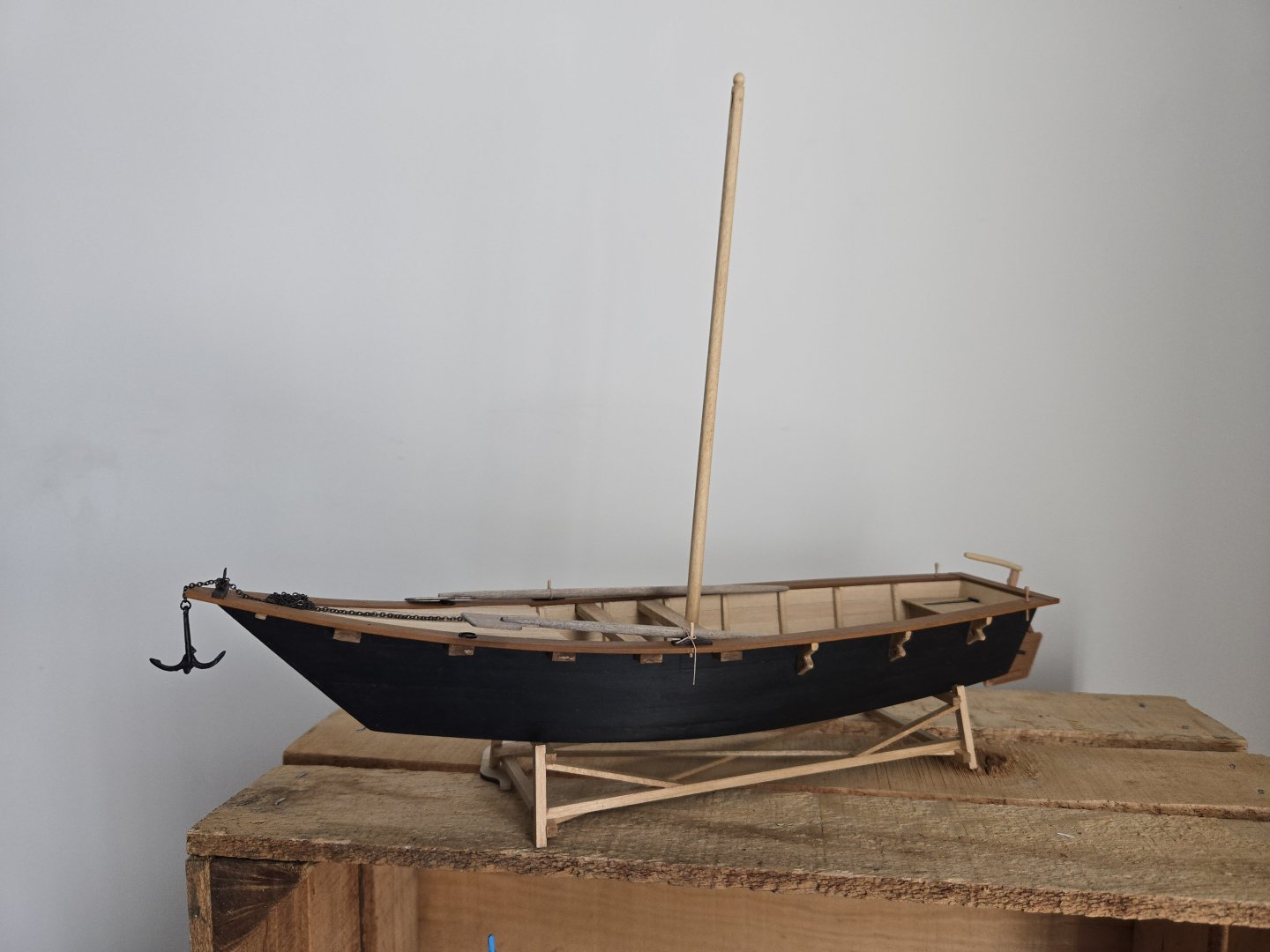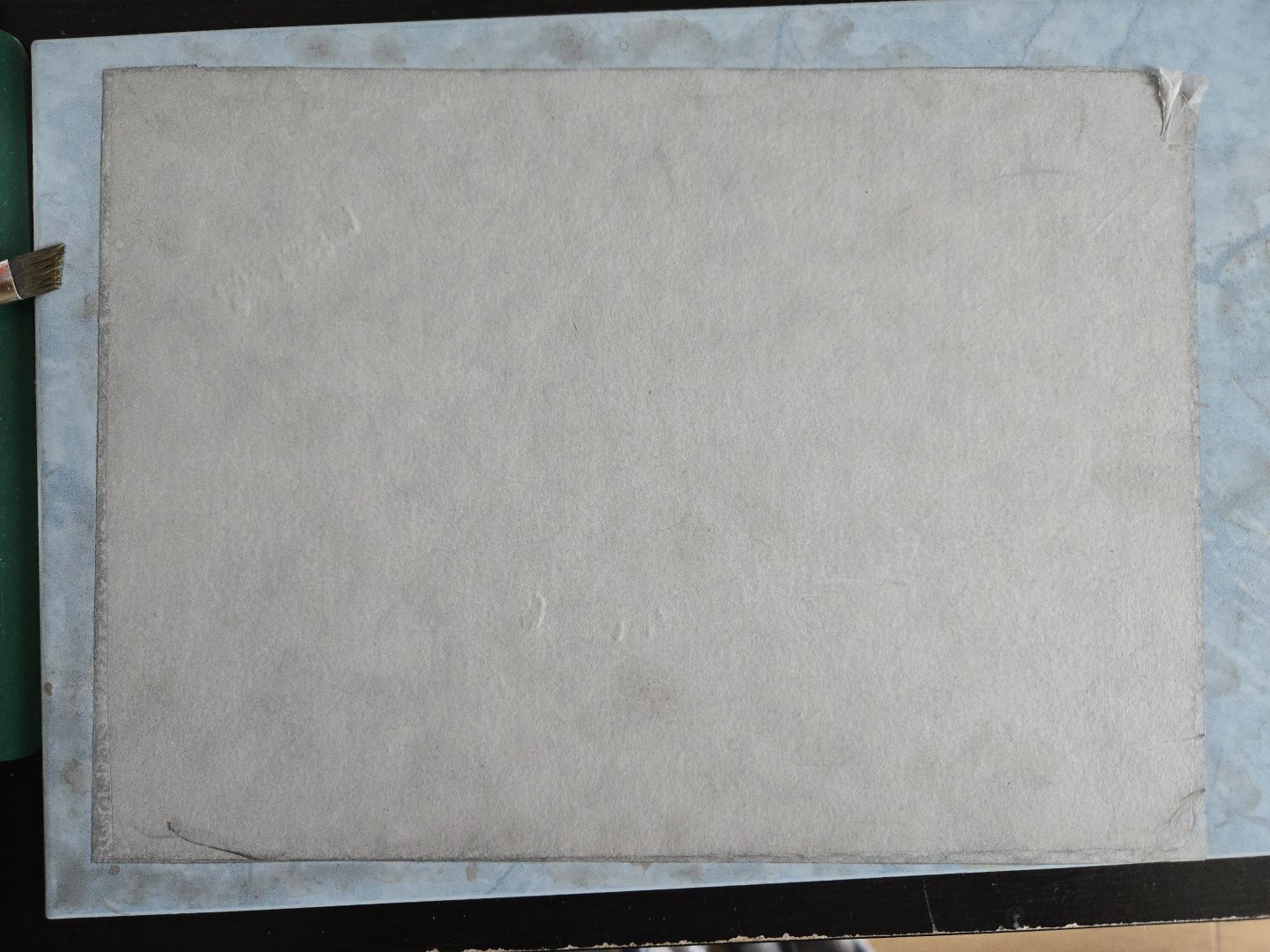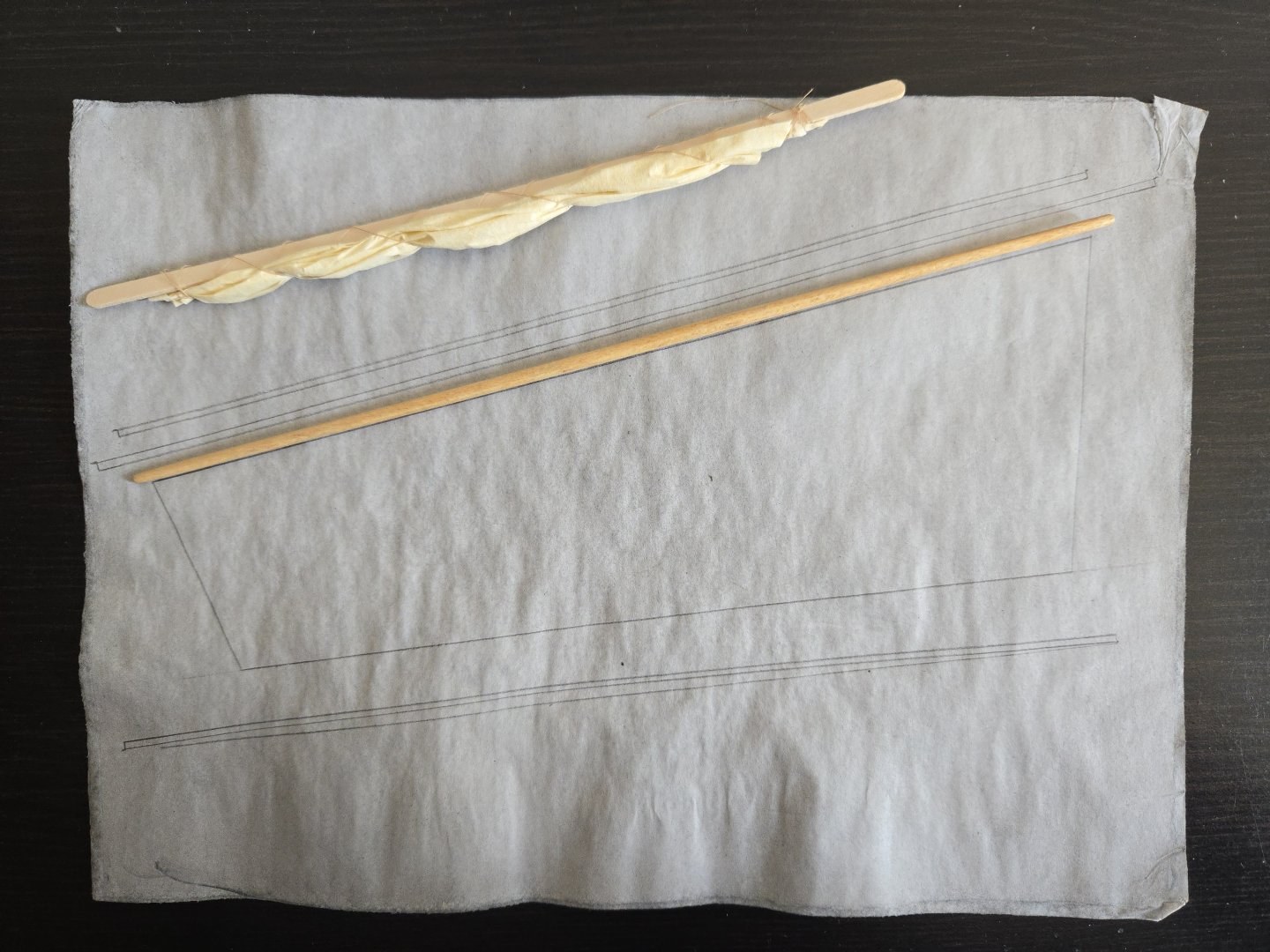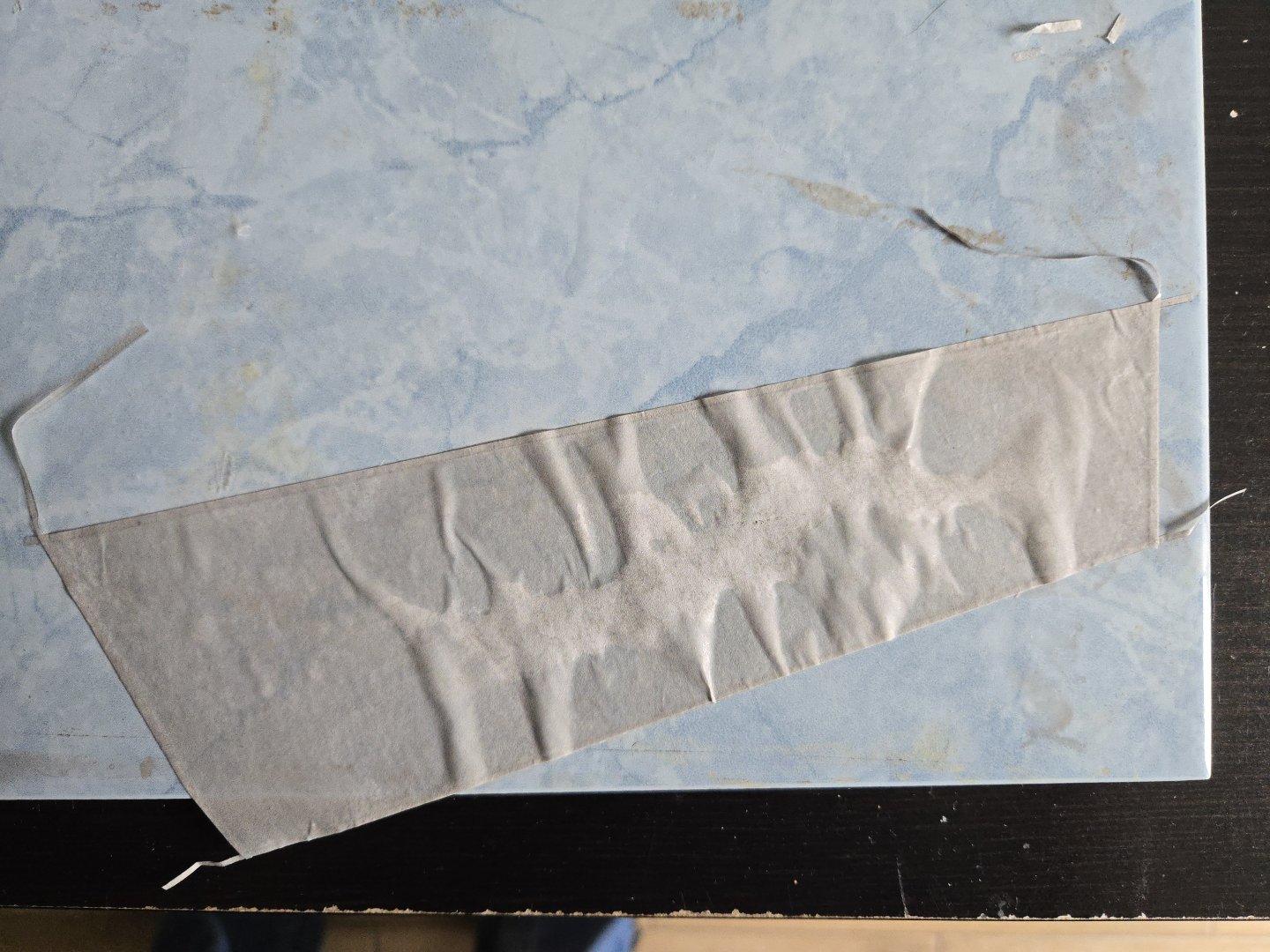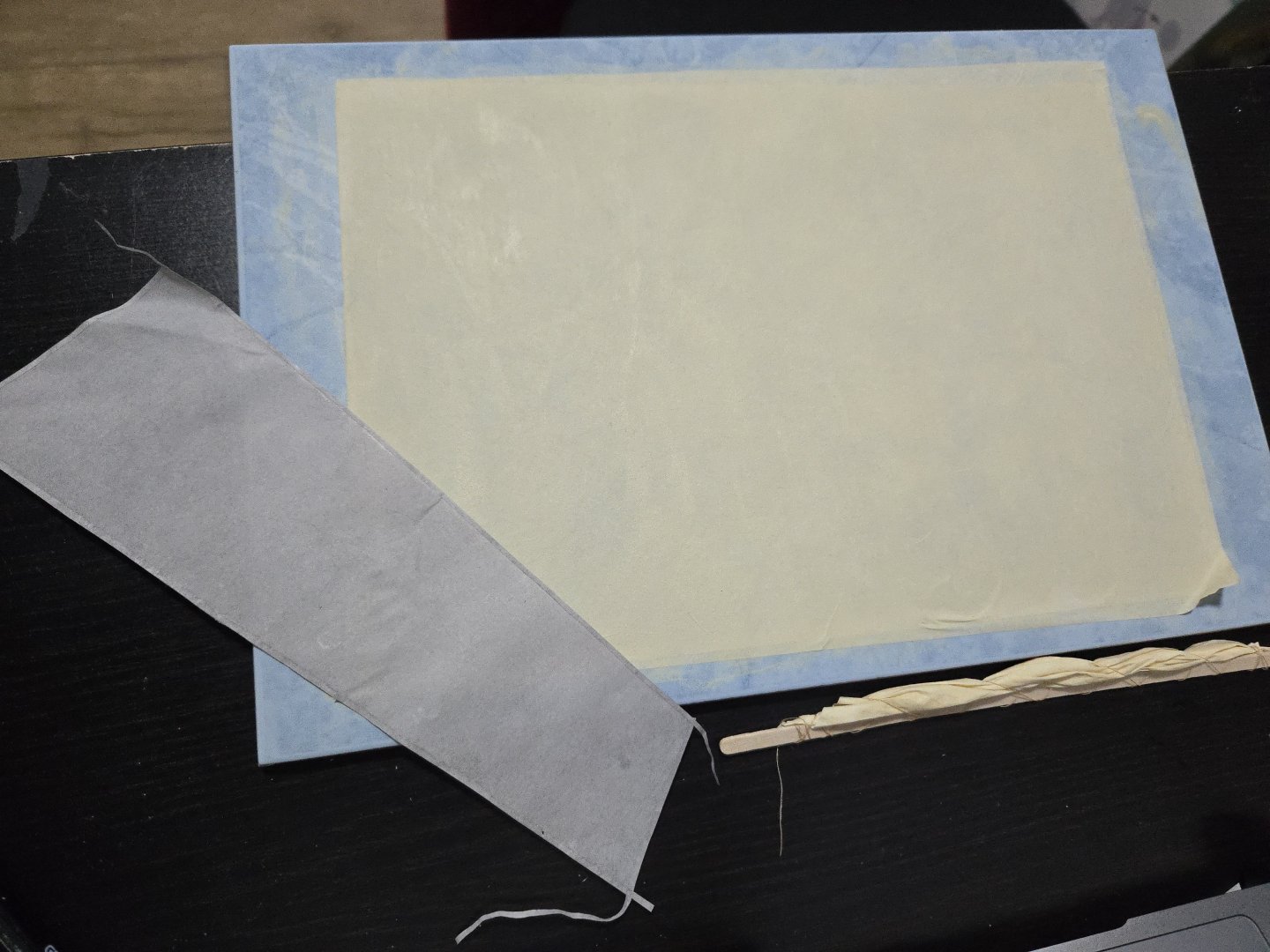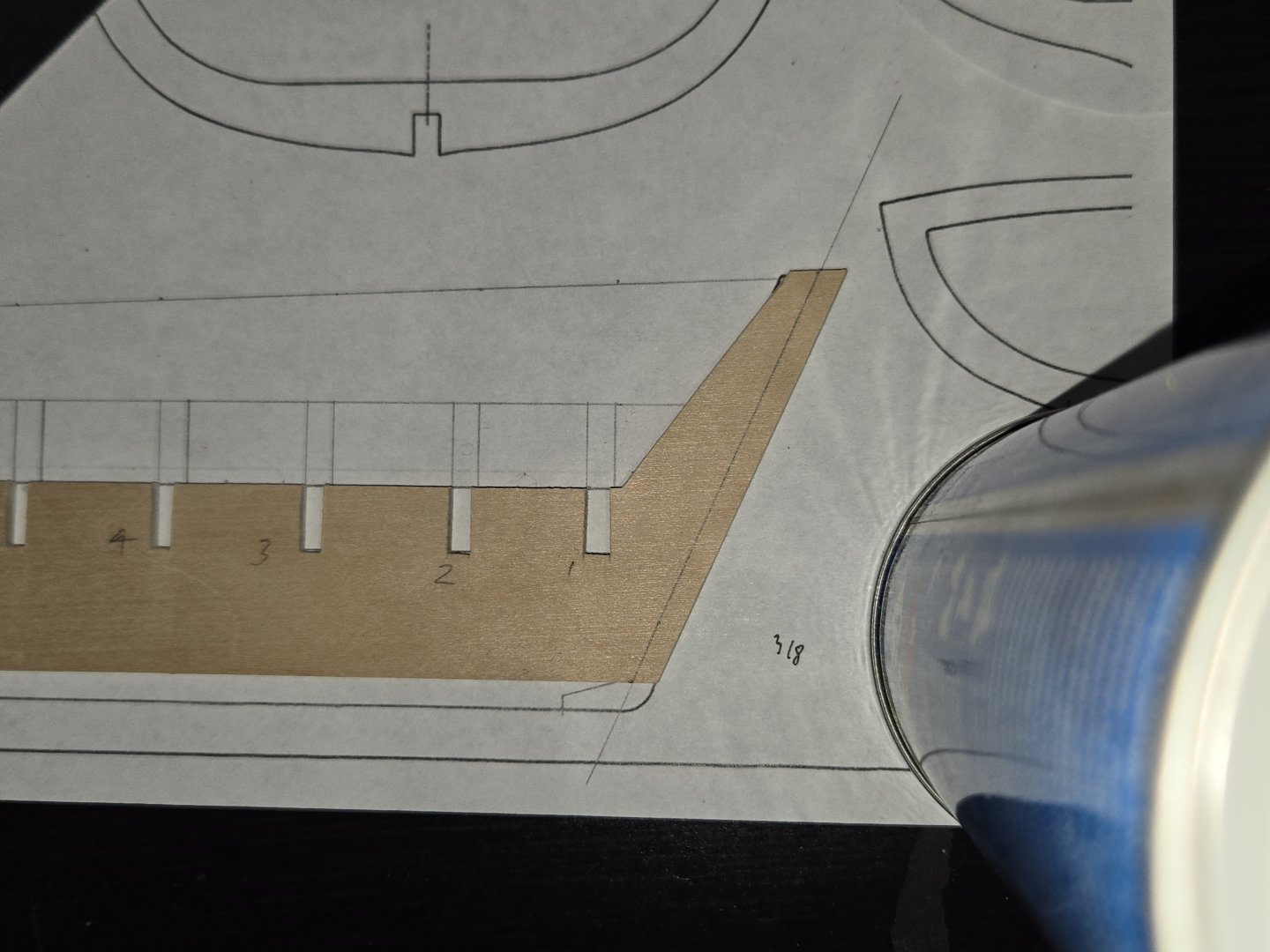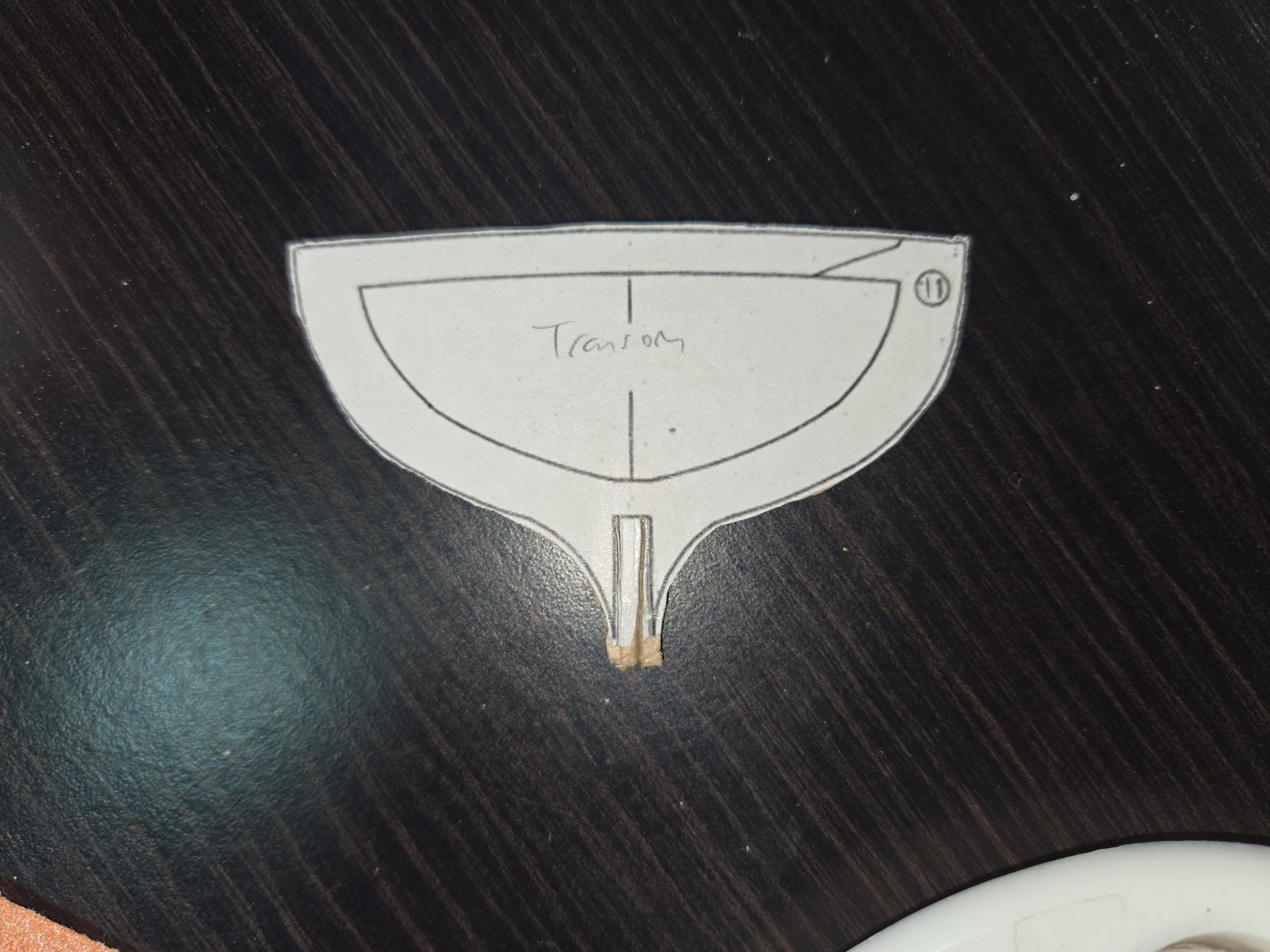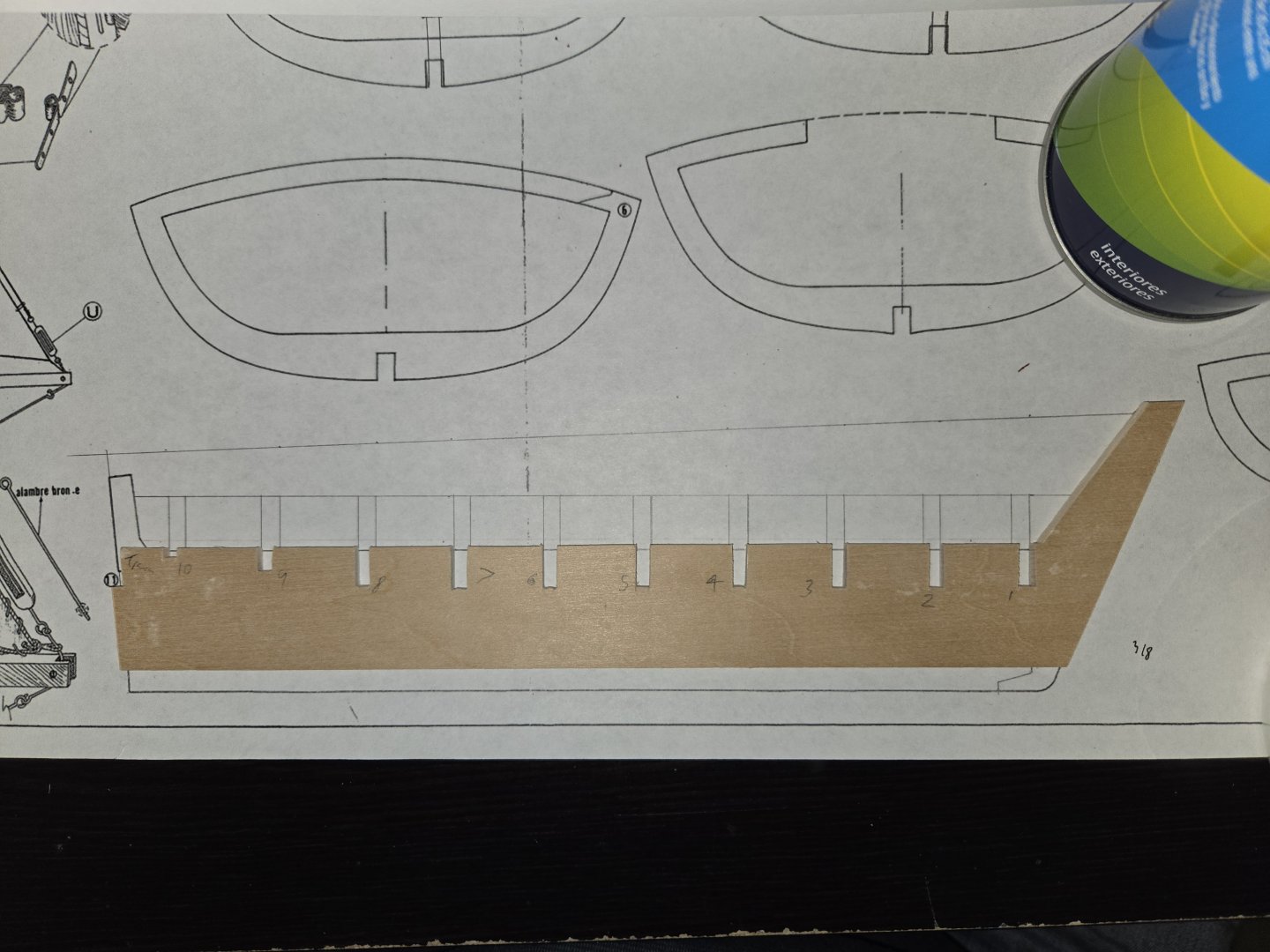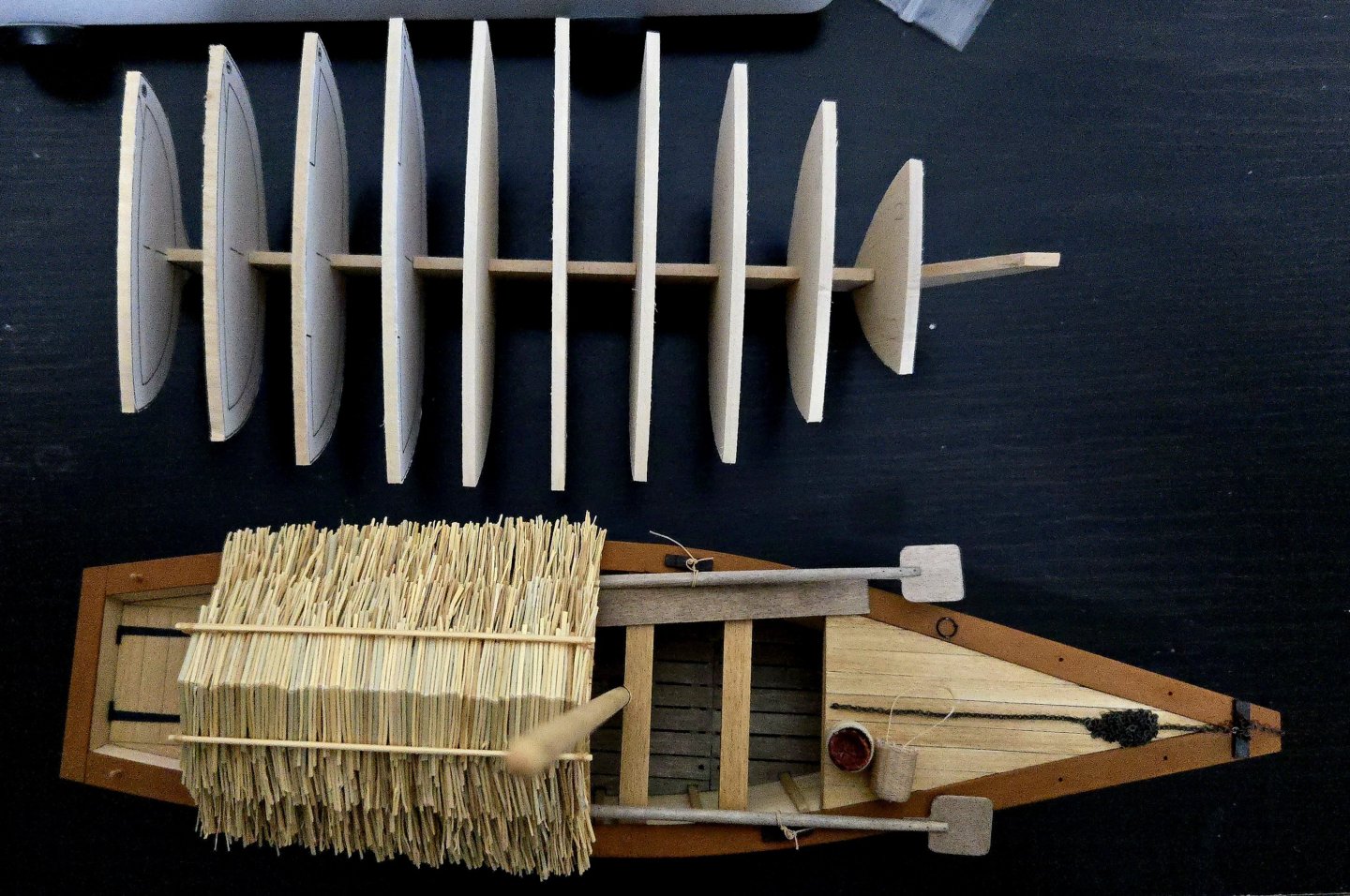-
Posts
1,309 -
Joined
-
Last visited
Content Type
Profiles
Forums
Gallery
Events
Everything posted by JacquesCousteau
-
Also, if anyone has any suggestions about how to best ensure that bulkheads are even and square on the backbone, I'd love to hear them.
- 312 replies
-
- Chile
- Latin America
-
(and 6 more)
Tagged with:
-
A bit more prep work on the lancha's skeleton. As mentioned above, the backbone was a bit oversized, so I trimmed off the excess on the front and bottom. I also extended the space for the transom. Later, I marked off the space for the rabbet (not pictured). There were a few places where I had cut too close to the line and the bulkheads needed to be built out a bit. In a couple places where it was more of a gouge, I added a bit of wood filler. For other spots, I built up multiple layers using thin scrap strips from planing. After the photo below, this was then sanded smooth. I was worried about imprecisions in cutting the slots, so I started thinking up ways to check before gluing how things are lining up. I hit upon the idea of loosely placing a 1/8x1/32-inch batten along the sheer line, clamped in only a few locations, as a way of doing a preliminary check for fairness. In general, the results were reassuring in that nothing seems to be disastrously off. A few bulkheads will need to be adjusted, especially number 6, which is notably short on one side creating a dip, and number 8, which is sitting a little high, and the bulkheads haven't been properly squared yet to the backbone. But other than those, the battens produced a more or less fair line. I was even able to use them to confirm that the transom, which I was worried I had cut too low, sits at the proper height. Next up, I'll be adjusting the fit (especially for bulkheads 6 and 8). I'm also going to add a 1/8‐inch-square strip along the bow so that the planking there can smoothly run into the rabbet. This will also substantially strengthen the projecting bow of the backbone, which is extremely flimsy due to crossgrain.
- 312 replies
-
- Chile
- Latin America
-
(and 6 more)
Tagged with:
-
Welcome, and very nice job on the hull!
-
Thanks! That would make sense, and if I remember correctly a lot of Spanish fishing boats had something like this. But, as far as I can tell they didn't do this on Canoas. Every photo I've seen is pretty clear that the only lines running down from near the top of the mast are the backstays and the halyard. Some photos also show the yard hanging quite a ways off the mast, suggesting a rather loose parrel. I'll have to think about it more. In any case, I'll be away from the build for a bit. I'm visiting my in-laws for Day of the Dead, and will be trying my hardest to eat my weight in tamales, mole, and pan de muerto over the next several days.
- 286 replies
-
Very interesting, informative responses to a worthwhile question. I recently wrote a little about this in the first post in my Lancha Chilota build log (link in signature), but to expand a bit, there are several things that motivate me in this hobby. I've liked making things since I was a kid, when I built dozens of plastic airplane models and then tiny whittled models of age-of-sail warships. I stopped when I went to college, but picked it up again recently, at a point in my life when I suddenly had more free time (there is a light at the end of the thesis tunnel) and also began to explore other hobbies. While I'm currently taking a carpentry class and quite enjoying it, part of what I like about modeling boats is that I can do it at my desk without needing a full wood shop. I find wood to be a wonderful medium to work with. It's a lot of fun to shape, especially to get a complex curve out of straight strips. I also find the work relaxing and almost meditative in how you end up focusing on one tiny thing at a time. It's a challenge, and it's fun to try out new methods and to see how your craftsmanship imporoves. In this way, it's like other hobbies, such as painting or dancing. Modeling also provides a very different way of engaging with history than I'm used to. When not making tiny boats, I'm an academic historian (at least until humanities and social sciences programs are fully defunded...) who works mostly with the methods and perspectives of social history. For me, scratchbuilding a model, especially of a "traditional" workboat, provides an in to start thinking about a lot of historical questions. How a boat type developed can say a lot about the spread of ideas and technologies, as well as about changing economies. The way that people built boats, the physical work done on them, and the question of ownership can tell us a lot about how people related to their means of making a living. (Not for nothing, many of the works of history I've most enjoyed reading, like Peter Winn's Weavers of Revolution, are deeply grounded in their understanding of how the nitty-gritty details of work shape broader social and political developments). And the way that boats can get taken up as cultural symbols can tell us something about the development of national and regional identities. So, modeling a workboat can help me to understand how people lived, worked, and understood some of the broader transformations of the past centuries. There are limits to what model building can tell, of course--it's most directly about working out technical issues, and can't in itself fully answer these broader questions. But it can get me started thinking about them. And there's no rule that I can't sidetrack my own build logs with long digressions along these lines. I've enjoyed not just the build, but the research and writing posts as another mode of thinking about history. That said, why boats and not, say, trains or cars? I don't think it has anything to do with my parents, as nobody in my family is particularly nautical (or has been into models, for that matter). Ultimately I think it comes down to personal aesthetics. Something about a wooden boat--maybe the curved hull, maybe the organized chaos of the rigging--appeals to me in a way that other objects don't. And I think it appeals to a certain buried romanticism in me, to see in a boat a sort of freedom (even if, historically, they generally meant anything but that). So, modeling allows me to combine my historical interests with the act of creating and building something that I find aesthetically appealing. Good luck with the thesis!
-
I checked on the plans how far apart the frames are supposed to be, and used scrap wood to make a small piece of the same width. After getting the first frame in place, I just placed the spacer to make sure each subsequent frame was even.
- 24 replies
-
- Indian Girl canoe
- Midwest Products
-
(and 1 more)
Tagged with:
-
Good fix from the ammonia problem! When I was making the Peapod, which has the same construction method, I found it useful to use a spacer block to help keep the frames even.
- 24 replies
-
- Indian Girl canoe
- Midwest Products
-
(and 1 more)
Tagged with:
-
A bit more progress. Now that the fishing equipment is in place, I attached the mast and finally glued the rancho in place. The mast isn't glued, but (besides being firmly held to the mast step with a wooden peg) is firmly lashed to the crossbeam with 0.7mm rope. After knotting it, I was able to slowly tug on lines to move the knot under the crossbeam and mostly out of sight. I also added the halyard with 0.7mm rope, using a knot as this seems like it would be easiest to remove, and placed the backstay. Neither is tied into position yet, but I wanted to see what things would look like. I've also started on the parrel, which is proving to be very tricky. On the Cargo Canoa, based on some very blurry photos, I made the parrel as basically a single line with a loop at each end, one to fit around the mast and one to fit around the yard. I've now found clearer photos that possibly show a very different parrel, as seen below: Source: https://memoricamexico.gob.mx/swb/memorica/Cedula?oId=vvts2osBVs6S4R6nk8il I see two ways of interpreting this. One, based on the way the parrel lines come closer to each other as they approach the yard, is that my original idea was basically right, but the parrel loop around the mast is simply quite wide. The other possibility I see is that the parrel is a single line with a loop at each end, but each loop goes around the yard, with the "body" of the parrel passing around the mast. Both options comport with other photos that show the parrel only loops around the mast once. It's also worth noting that the parrel is not very tight to the mast. At the moment, I'm torn about the best way to approach the parrel, both in terms of which option given above makes the most sense and in terms of which knots to use. As both options involve at least one loop around the yard, I initially began with a simplified splice in 0.6mm rope. But, I began to wonder whether a simple knot would make more sense. From what I've seen in photos, the yards were regularly removed from the mast, and this would be much easier to do with a knot than with a spliced and served loop (the latter of which would require the long yard to be awkwardly slid out of the loop). So, I started redoing the parrel with knots. I began with a clove hitch, but this seems very bulky, especially if there will be a second parrel loop around the yard. So, if anyone has any suggestions about how to handle the parrel, I'm all ears.
- 286 replies
-
Thanks! I was able to do that with the ropes tying the oars to the oarlocks, but I had a hard time getting enough pressure into the bottom of the hull around the crossbeams and other parts and so went with glue for some ropes.
- 286 replies
-
Thanks, I'll definitely give that a try! Thanks! I've also glued the fishing equipment into place, pretty much where I originally positioned it. I just moved one of the nets a bit forward so it would be more visible. This has been a straightforward process. The trickiest part has been that some ropes and other parts needed to be glued down so they weren't sticking up unrealistically. One particular challenge was that the chinchorro net's floats couldn't really be pressed down any further and appeared to be floating a bit, as can be seen (not very well, admittedly) below, just next to the mast step: So, I looped up some scrap rope and rolled up some scrap netting to add under it, so it looks more like the floats are just on top of a wadded-up net. I'm still deciding whether to do the rope and the net (first picture), or just the rope (second): In any case, this is the longest I've had the rancho off since I added the rudder, oars, anchor, and other parts, and I don't think it looks half bad. Still definitely going to keep the rancho, though!
- 286 replies
-
A bit of slow, halting progress on at least some parts of the build. Some people have made quite nice sails from tissue paper, so I thought I'd give it a try, as it's very cheap (I picked up several sheets for a few cents). I felt that my first test sail had been a little too cream-colored, so I tried to make it a bit more gray. A tiny drop of black paint goes a long way! I felt the color was a little dark, but I continued anyway as I could at least use it to test the tissue paper. As can be seen below, it seemed very smooth on the tile, but removing it from the tile (which required a bit of water) left it very wrinkled. I decided against adding separate panels or drawing on the panel lines, because I think they will be entirely invisible in the furled sail. I did, though, decide to try adding the reinforcing strips around the edges. Unfortunately, it was quite difficult to add these, or more accurately, to remove the sail once they were added. The attempt led to several rips and tears, and the reinforcements came off in several places. I realized that part of the issue is that the tile backing needs to be thoroughly cleaned after each use. Things stick too well if there's any residue. Having learned that lesson, I decided to keep using the gray sail as a test, while making a new sail in a better color with greater care: I'll see how this goes. I have to say that the tissue paper is much flimsier than the coffee filter (which is an obvious point I suppose).
- 286 replies
-
Good question! I've mainly just used basswood strips, 1/32-inch thick, cut from sheets or scrap, but I've also used 1/16‐inch thick strips as well. Usually I go with something fairly thin, maybe 1/8-3/16-inch wide, and at least 5 inches long or longer. I've also used coffee stir sticks, some of which are 1/32-inch thick birch. In general you just want the batten to be thin enough to flex around the curves. I broke a few battens trying to fair the bow of my half-hull, perhaps soaking them would have helped but in hindsight it was a sign that a bit more fairing was needed.
- 84 replies
-
- half hull planking project
- NRG
-
(and 2 more)
Tagged with:
-
Thanks! At the moment, I'm finishing up a Mexican fishing/cargo lake boat, the Canoa de Rancho, and I just started a build of a Chilean coasting sloop, the Lancha Chilota. I'm hoping to build some more small oar-powered vessels soon, as well.
- 65 replies
-
- Maine Peapod
- Midwest Products
-
(and 1 more)
Tagged with:
-
Thanks, I'm looking forward to seeing how you build it with the sail!
- 65 replies
-
- Maine Peapod
- Midwest Products
-
(and 1 more)
Tagged with:
-
Thank you all for your helpful comments! One tricky aspect of the plans is that they don't say or show anything about the planking thickness or the rabbet (they also don't include a lines plan, just drawings of each bulkhead). They do say that the bulwark should be made of a 2x8mm strip at 1:20 scale, which is a bit under 1/16 of an inch thick at 1:32 scale, but it's not clear if the planking should be the same thickness. So, taking advantage of this build being a generic type model rather than representing a specific vessel, I will plan on adjusting the rabbet for a single layer of 1/32-inch thick planking. This may lead to slightly differently proportions than those given on the plans, but the finished hull should still be a good representation of the type. In any case, I've been using a curved sanding block to finalize the shape of the bulkheads. As I go, I'm marking out a center line on each and using a small square to measure on each side. So far, the frames have been very symmetrical. I've also marked where I'll need to trim back the bow of the backbone to fit the stem.
- 312 replies
-
- Chile
- Latin America
-
(and 6 more)
Tagged with:
-
I didn't see your post until I had already written mine, but I think that we're saying the same thing. My one suggestion is that, instead of adding wood filler to build the corner of Frame H back up, it might be easier to shape some scrap basswood. Very nice job of problem solving!
- 84 replies
-
- half hull planking project
- NRG
-
(and 2 more)
Tagged with:
-
I think the counter is the most complex part of this model, and it doesn't help that the instructions are not very clear. I found it helpful to look at images of completed builds to try to reconstruct what the counter looked like. My sense is that the instruction to not sand the aft edge of frame H until the counter is added later in the build is a little bit of a simplification, because it's impossible to fair the hull without touching H, especially for the complex curves of the tuck stern. I think the main point is that the counter will form a horizontal line across rhe back of frame H, and the outermost edge (where the wale intersects) needs to not be sanded down. But I think it's ok to sand frame H closer to the sternpost in order to fair the stern curves. It might be useful to draw a line to mark where the counter will be placed, in order to not sand past it. Come to think of it, I don't really remember why the counter is supposed to be added later.
- 84 replies
-
- half hull planking project
- NRG
-
(and 2 more)
Tagged with:
-
Now that the log is caught up, there are a few issues I should note and some questions I wanted to ask, as this is my first full-hull POB build. The tl;dr version is that: 1) I screwed up but saved the transom, 2) I need to reshape the backbone a bit, 3) I'm debating single- vs. double-planking with 1/32‐inch thick basswood and would love to hear your thoughts, and 4) I'm considering whether adding a couple stringers would help with fairing the bulkheads, or just make it more complicated. First, I made a mess of the transom. The plans give a hollowed-out transom (like the other bulkheads that, interestingly, doesn't slot into the backbone from above, but from the aft side. I decided to simplify this, making the transom notch like that of the other bulkheads. However, after cutting it to its current position, I realized that I was setting myself up for a very weak transom, as it would have fairly long, narrow sides running along the bottom. I decided that, instead of notching both the backbone and the transom, I would just leave the transom un-notched and do an extra-long notch in the backbone. Unfortunately, before extending the backbone notch (which I still have to do), I forgot about my plans and started cutting a notch in the transom. I remembered midway through cutting. Thankfully, the transom will be planked, so I decided to just fill the saw gap with glue and continue. Hopefully this doesn't make fairing more difficult. If necessary, I can simply cut a new transom. Second, more importantly, I messed up a bit on the backbone. As can be seen, for whatever reason I forgot to remove the amount equal to the separate stem piece from the fore end, so it's too long and I'll need to recut it. Not the end of the world, but a bit embarrassing and a good reminder to double-check before cutting. The photo above also shows another issue. I cut out the backbone a little wide as I was anticipating doing a fair bit of sanding, but I didn't end up sanding nearly as much as I thought I would. So, I need to trim down the bottom of the backbone to bring it to the proper size. (I also need to add a mast step to it). Which brings me to another important issue: how much space I should leave for the rabbet. I originally planned this out for a double-planked hull, as that seemed like the most common way to do POB builds and I was very worried about getting a smooth hull. However, since then, I planked the NRG Half-Hull (yes, this build has been languishing for a while), which is single-planked and unpainted. Although my build has plenty of errors, I was overall happy with how it turned out. So, I'm reconsidering whether it really would make sense to double-plank the lancha hull (especially as 1/32‐inch-thick basswood is not available here, so I'd be using up nearly my entire supply). While I'm sure that I'll make some mistakes, it will be painted black and so I can readily fill in any gaps or flat spots. Looking at other threads, it seems there's been some debate over single- vs double-planking, with many saying that double-planking is often used in kits because it allows you to get away with fewer, widely spaced bulkheads. In this build, the bulkheads are mostly spaced 3/4 of an inch apart, which is pretty close. All of which is to say, I'm currently leaning toward single-planking. However, this will require a much thinner rabbet than I currently have set. I'm curious as to whether it will be possible to change midway through to double-planking if it seems like my hull is turning out too uneven, or if that will be impossible if the rabbet is already full. I also wanted to ask if 1/32‐inch thick planks are going to be too thin. I feel like 1/16 would be hard to shape to these curves, and I don't have 3/64 thick wood. Then again, I used 1/32-thick wood on the Half-Hull. Finally, I'm a bit concerned about getting everything lined up. I was thinking that it might be useful to try adding a stringer connecting the bulkheads, specifically in the corner (I'd just have to carve out a little notch in each corner). I was thinking of a 1/16-inch square strip. My thought is that it would make it easier to see how the hull is lined up. Then again, if I add it before I've faired the bulkheads, it's probably going to be off and will itself need to be faired. And if I add it after the bulkheads have been faired, it seems kinda pointless and like I may as well just add the false deck and start planking. So I'm leaning toward no stringers, but thought I'd see if others had thoughts on the matter. (Another possibility may be to add stringers under the deck extending out in a line from the sides of the main hold, which would in theory be much less difficult to fair.) So, to reiterate, my main questions are about single- or double-planking, whether 1/32-inch thick planking is asking for trouble, and whether adding stringers would actually be helpful or will just make things more complicated. In any case, here's a size comparison so far of the Lancha Chilota to the Canoa de Rancho (which is one foot long). Both are in the same scale. The lancha is shorter, deeper, and much wider. It will also have a significantly taller mast and rig.
- 312 replies
-
- Chile
- Latin America
-
(and 6 more)
Tagged with:
About us
Modelshipworld - Advancing Ship Modeling through Research
SSL Secured
Your security is important for us so this Website is SSL-Secured
NRG Mailing Address
Nautical Research Guild
237 South Lincoln Street
Westmont IL, 60559-1917
Model Ship World ® and the MSW logo are Registered Trademarks, and belong to the Nautical Research Guild (United States Patent and Trademark Office: No. 6,929,264 & No. 6,929,274, registered Dec. 20, 2022)
Helpful Links
About the NRG
If you enjoy building ship models that are historically accurate as well as beautiful, then The Nautical Research Guild (NRG) is just right for you.
The Guild is a non-profit educational organization whose mission is to “Advance Ship Modeling Through Research”. We provide support to our members in their efforts to raise the quality of their model ships.
The Nautical Research Guild has published our world-renowned quarterly magazine, The Nautical Research Journal, since 1955. The pages of the Journal are full of articles by accomplished ship modelers who show you how they create those exquisite details on their models, and by maritime historians who show you the correct details to build. The Journal is available in both print and digital editions. Go to the NRG web site (www.thenrg.org) to download a complimentary digital copy of the Journal. The NRG also publishes plan sets, books and compilations of back issues of the Journal and the former Ships in Scale and Model Ship Builder magazines.




